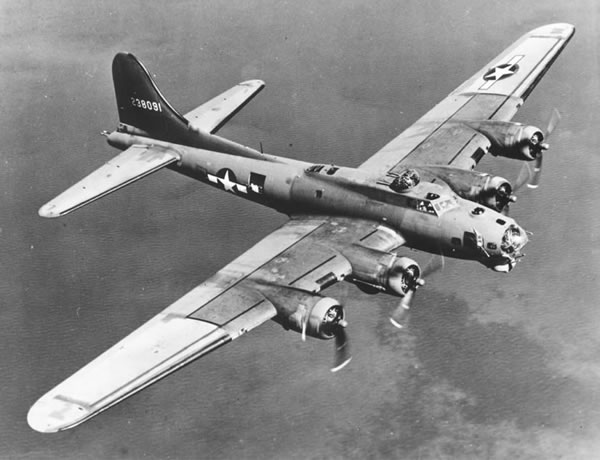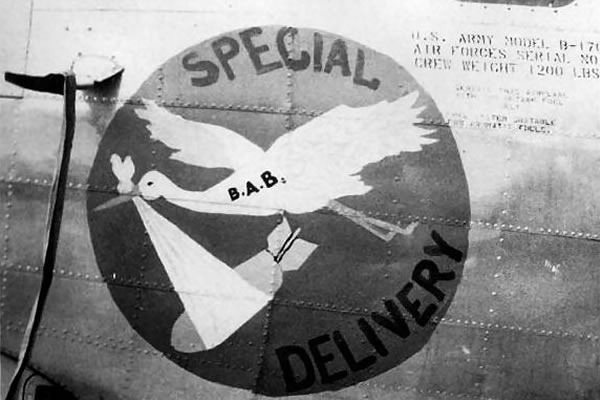Flying Fortress down at August Pitts

A B-17 Flying Fortress Bomber returning from Frankfurt crash landed at August Pitts in 1944
A series of incidents brought a USAAF B-17 Flying Fortress crashing down in Horsmonden. Here is some information about the Flying Fortress and some background information about the mission.
Over 8,000 men and women served in the 303rd Bombardment Group (H) ‘Hells Angels’, USAAF Eighth Air Force, B-17 Bomber Group based at Molesworth in Cambridgeshire from 1942 to 1945.
Their motto, Might in Flight, was earned on each of their record 364 combat missions. One of their aircraft crash landed at August Pitts, Horsmonden after a bombing mission to Frankfurt.
Bombing Mission to Frankfurt
INCIDENT 1: 11 February 1944 mission #108 to Frankfurt, Germany in B-17 #42-39810 Big-A Bird 358BS (VK-E).
Two engines were shot out a few seconds after bombs away. None of the gun turrets had power. Knowing that they had a fuel shortage, Lt Worthley tried to reach the RAF emergency field at West Malling in Kent.
The remaining two engines cut out and the Fortress went down through some oak trees. The tail section remained in one of the trees and the #4 engine was torn off. The B-17 came to rest in a hop field of the August Pitts farm near Horsmonden.
Seven crewmen were injured: Ratay (N) broken left leg; Blum (B) broken left arm; Egan (R) broken right arm; Vanderhoff (BTG) broken leg and facial cuts; Malherbe (RWG) fractured right hip; Robinson (LWG) dislocated hip; Lawson (TG) broken right leg. Vanderhoff (BTG), after recuperation, went on to complete his 35 mission combat tour on 17 Sept 1944. The other wounded crewmen were sent back to the USA for rehabilitation. S/Sgt E.D. Johnson (E) was killed in the crash. Worthley (P) and Crook (CP) had no serious injury.
JOE R. WORTHLEY CREW – 358th BS
(crew assigned 358BS: 14 Nov 1943 – photo: 06 Dec 1943)

Photograph
(Back L-R) Sgt Benjamin F. Malherbe (RWG); 2Lt Eugene C. Blum (B); 2Lt Joseph B. Ratay (N); 2Lt Kenneth D. Crook (CP)(POW)(2); 1Lt Joe R. Worthley (P-KIA)(1)
(Front L-R) Sgt Grant W. Vanderhoff (BT); T/Sgt Edwin D. Johnson (E)(KIA)(3); T/Sgt Harry R. Egan (R); S/Sgt Fred B. Larson (TG); S/Sgt Ray I. Robinson (LWG)

Mission Report
303rd BG (H) Combat Mission No. 108 took place on 11 February 1944, the target being Frankfurt in Germany. There were 21 crews dispatched with 1 KIA and 7 injured. The length of mission was 8 hours. Frankfurt was bombed for the fourth time since 29 January 1944. Six of the 21 aircraft
airborne were abortive.
Fourteen aircraft attacked Frankfurt with 16 1/2 tons of 500-lb. A.N. M43 bombs. Nine tons were jettisoned. Three aircraft carried long-delay fuses. Strike attack photos showed the bombing from 25,000 feet to be poor. One cluster of bombs fell seven miles southwest of the city causing no damage and another group fell two miles northeast of the city in a sparsely settled residential area.
P-47s escorted bombers on penetration, P-51s and P-38s provided target support, and P-47s and RAF Spitfires escorted the B-17s on withdrawal. Approximately six to eight enemy fighters were seen. No attacks were made on the 303rd BG(H) and no enemy aircraft claims were made. Flak at the target was moderate and accurate. Chaff was discharged from the vicinity of the IP until two minutes past the target. Crews reported it as effective, but the flak continued after the formation left the target. Rockets from the ground were seen just after leaving the target, but went far above the formation with no explosions observed.
Ten aircraft returned to Molesworth after completing the mission. Four aircraft sustained major damage and five sustained minor damage.
The other five limped back to England including the one which landed in Horsmonden…
The Horsmonden Flying Fortress
Big A Bird #42-39810, 358BS-E, piloted by 2Lt. Joe Worthley, had numerous problems. Two engines were shot out a few seconds after bombs away.
They were unable to keep up with the formation or maintain altitude. None of their gun turrets had power. Fortunately they had no enemy fighters around. Knowing that they had a fuel shortage they tried to reach the RAF emergency field at West Malling. They assumed crash landing positions in the radio room [located under the dorsal gun position] since they were too low to bail out.
The two remaining engines cut out and the Fortress went down through oak trees. The tail section remained in one of the trees, the No. 4 engine was torn off and the B-17 came to rest in the hop field of August Pitt’s farm near Horsmonden, Kent, England. S/Sgt. Edwin D. Johnson, engineer, was killed in the crash.
Seven crewmen were injured: Lt. Joseph B. Ratay had a broken left leg, Lt. Eugene C. Blum had a broken left arm, S/Sgt. Harry R. Egan, had a broken right arm, Sgt. Grant W. Vanderhoff had a broken leg and face cuts, S/Sgt. Benjamin F. Malherbe fractured his right hip, Sgt. Ray I. Robinson had a dislocated hip and Sgt. Fred B. Lawson had a broken right leg.
Lt. Kenneth D. Crook, the co-pilot, was not injured. He became a PoW following the 24 February mission to Schweinfurt. The rest of the injured crewmen were sent back to the USA for rehabilitation.
Pilot, 2Lt. Joe Worthley, flying with a different crew, was killed over Berlin on 24 May 1944 from a direct flak hit in the cockpit. He was on his 25th and last mission.
Eye Witness Accounts
Lt. Deane Barnes, pilot of Buzz Blonde 427BS-S said, “We didn’t see where our bombs landed, but we could see through a hole in the clouds that we were over the target when the bombs were dropped. There were a few enemy fighters around, but our fighter cover was so perfect that the Germans couldn’t get at us.” Fighter cover was also praised by S/Sgt. Lowery Weed, top turret gunner of Mizpah who said, “We had everything under the sun for fighter escort. They didn’t let anything come near us.” “The flak wasn’t as bad as last time,” said Sgt. Andrew G. Benevento, radio operator on Buzz Blonde. We saw a few fighters, but they stayed down below us and wouldn’t come up and mix with us at all.”
Lt. Litman, pilot of Clover Leaf 358BS-C, was critical of the last fighter support believed to be RAF Spitfires. He stated, “They were dog-fighting and fooling around among themselves. This action caused our crew undue suspense–believing that there were enemy aircraft present.”
Bombing Raids on Frankfurt
The city of Frankfurt am Main was severely bombed by the Allies during World War II. The city centre was destroyed by numerous air raids and about 5,500 residents were killed. The famous medieval city centre and historic Paulskirche were destroyed.
On 29 January 1944, the USAAF Eighth Air Force bombed Frankfurt during daylight. That day Princess Marie Alexandra of Baden was killed in an air-raid on Frankfurt.
On 22 March 1944, a Royal Air Force attack destroyed the old part of Frankfurt and over 1,000 inhabitants died. The east port, a significant shipping point for bulk goods with its own rail connection, suffered major damage.
303rd Bomb Group (H) website
Most of the information in this article is takend from this website. It is well worth a visit and forms an important historical record of their activity.
